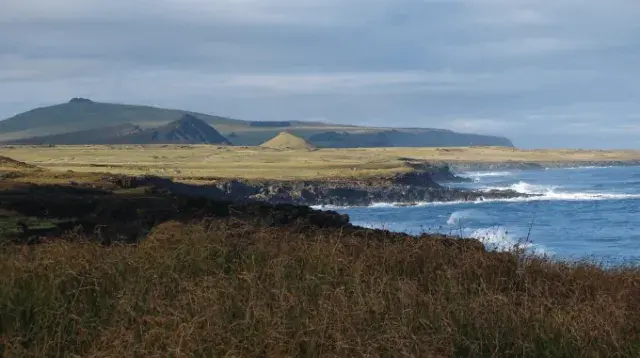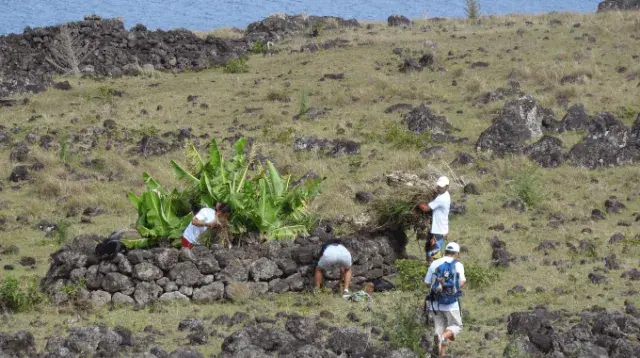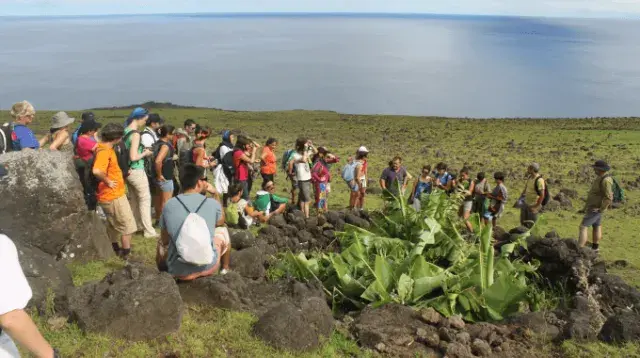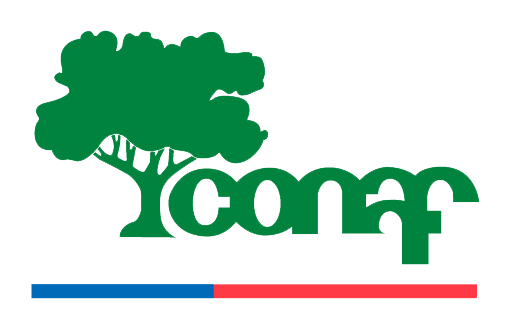Ancestral knowledge to the rescue for indigenous plants
Nestled on the edge of the South Pacific, Easter Island (or Rapa Nui, literally “Big Rapa” in the native language) has always had an extraordinary ability to fascinate people. But while the mysterious moai statues that adorn its shores have long received the protection they rightly deserve, the plant biodiversity of this unique ecosystem is struggling to achieve the same level of preservation. Until a unique project by our Chilean partner CONAF came along, that is...
An isolated and endangered heritage

A Chilean territory since 1888, Easter Island lies more than 3,500km off the Chilean coast. The nearest inhabited land, Pitcairn Island, is over 2,800km away. But Rapa Nui is isolated in more ways than one! Just 166km² of land forms this eco-region in its own right, home to the last vestiges of a once rich and entirely unique biodiversity.
Only 48 native plant species are left today, 11 of which are endemic. 13 are classified as endangered or critically endangered, while 14 are considered vulnerable. A much more understated heritage than the moai statues, perhaps, but just as essential to both the history and future of the 7,750 Rapa Nui people who call the island home.
Where have all the plants gone?
What happened to the botanical biodiversity of Easter Island? A question almost as fascinating as the closely related issue of the collapse of the Moai civilisation itself. Today, the island is striking for its flatness and lack of vegetation. Yet 18th-century European explorers spoke of vast forests of toromiro and ferns, while archaeologists have discovered the presence of more than 25 different tree pollens in the sediment, as well as traces of palm roots and nuts. Many theories have been put forward over the years, including massive deforestation leading to profound changes in the water cycle and colossal loss of biodiversity that was simply unable to survive faced with the combined dangers of drought and soil erosion.
At least in the 21st century, we’re able to have clarity on the threats to the island. Today, 90% of the land is covered by invasive exotic species that leave little chance for native plants to survive. Climate change is multiplying extreme phenomena, with prolonged drought over the last ten years and frequent fires. Agriculture is intensifying, as is uncontrolled herbivore grazing.
But Easter Island’s plant heritage isn’t just worthy of interest from a scientific point of view, it constitutes a genuine living history, right at the heart of ancestral cultural and artistic traditions, and an important part of recording that history, which urgently needs to be protected and shared.
Restoring the present and securing the future by drawing inspiration from the past

Led by CONAF (Chile’s National Forestry Corporation) and supported by Klorane Botanical Foundation, the project aims to conserve 60% of the island’s flora by creating a botanical conservation zone covering more than 4,000m2, a seed bank, as well as a series of traditional buildings.
One of the keys to this system is a 100%-local farming technique: manavai. Literally meaning “the power (mana) of water (vai)”, these volcanic stone circles are an island innovation that speak volumes about resilience in the face of environmental change. Inside these circular structures, native plants maintain a level of humidity that’s conducive to their growth and propagation, protected from both bad weather and drought. This means they can be preserved for food, reproduction, art, construction and even traditional ceremonies.

Around twenty of these manavai structures will be built in open areas adjacent to the Mataveri Otai nursery, which is run by CONAF. This education and conservation centre will be home to some of the island’s most symbolic species, including the toromiro (Sophora toromiro, extinct but being reintroduced), the mako’i (Thespesia populnea), the marikuru (Sapindus saponaria) and the pua (Curcuma longa, which you might know as turmeric).
The project also aims to involve the Rapanui community by using this approach as a way of raising awareness and educating local people about the environment and indigenous techniques. Planting will be carried out with groups of children, who will also be taught how to build a manavai themselves. As well as getting young people involved in sharing traditional knowledge, this ancestral system will help raise the profile of a model that can be replicated easily in homes across the island, in hotels and public buildings, thereby extending the scope of conservation efforts.
Restoring plant biodiversity on Easter Island responds to the triple objective of ensuring the resilience of the ecosystem, combating the effects of climate change by strengthening the soil and the water cycle, and reconnecting communities with their history and ancestral knowledge.
Thanks to our long-term conservation efforts, CONAF has succeeded in developing a botanical garden and seed bank. We’re now expanding our project by reviving traditional techniques and shifting the focus to the community. Education and awareness are essential if our work is to last for generations. It’s also a fantastic way of reconnecting our societies with our environment and repairing that vital bond
Our partner :
Corporación Nacional Forestal (CONAF) is a private organisation that works with the Chilean Ministry of Agriculture and is responsible for the country’s forestry policy. The organisation works to conserve and manage forest zones, in particular by encouraging regreening and awareness-raising projects.

